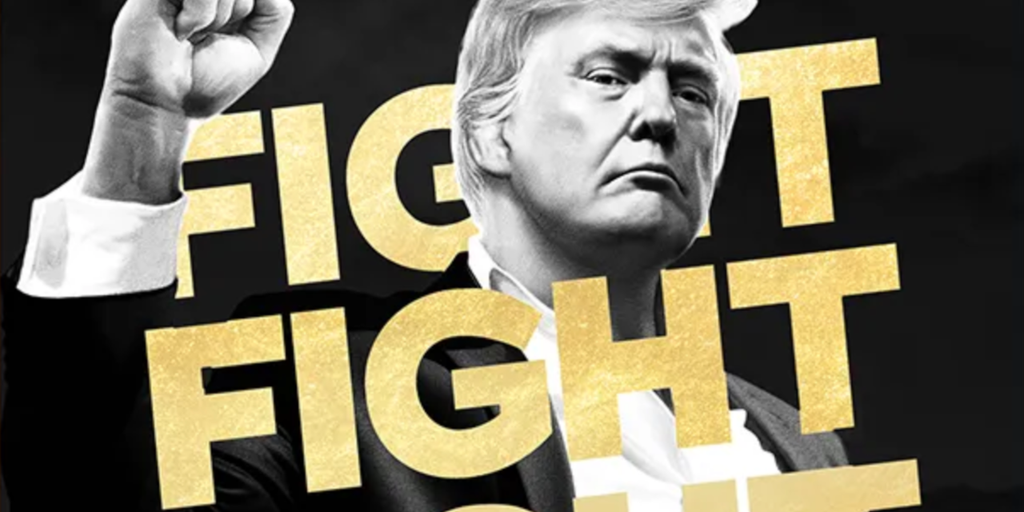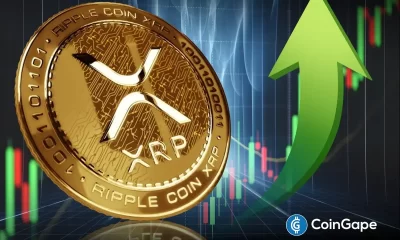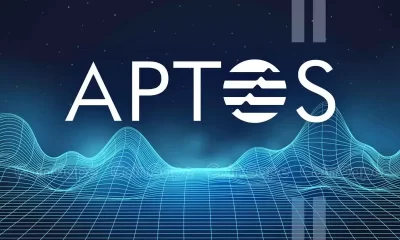Coins
McDonald’s Reveals Doodles Collab for Coffee and Collectibles
Published
5 months agoon
By
admin

The golden arches are getting a pastel makeover for the holiday season.
Fast food giant McDonald’s and Web3-native brand Doodles revealed a collaboration Thursday, featuring custom cups that showcase the Ethereum NFT collection’s colorful, hand drawn style. On top of that, customers can unlock digital collectibles and content, as well as access co-branded physical merchandise.
Dubbed the “GM Spread Joy” campaign, the marketing initiative is being billed as an immersive experience that pays homage to the Crypto Twitter mantra. Available to customers in the U.S., the promotion can be accessed at participating stores among McDonald’s 13,500 restaurants.
The limited-edition cups, emblazoned with pinks and blues amid holiday-themed tableaus, allow customers to access a “pack ripping” experience, McDonald’s said in a press release.
Dovetailing with Doodles’ digital avatars, they contain accessories and apparel for Doodles characters, among other goodies, like access to music videos and Doodles’ animated series. In addition to the original Ethereum NFT collection, Doodles has launched an avatar creation “Stoodio” app on Ethereum layer-2 network Base, where the digital items can be used.
Outside the U.S., where NFT projects haven’t faced intense regulatory scrutiny, the burger chain has used NFTs to promote its purple icon Grimace and launched a metaverse game called My Happy Place. What’s more, McDonald’s tapped The Sandbox, an Ethereum-based metaverse game, to pay tribute to its chicken nuggets.
McDonald’s collaboration with Doodles may represent its biggest step into the NFT space since its American division unveiled McRib-inspired NFTs in 2021. Effectively, McDonald’s was an early adopter of using digital assets as a way to reward customers and cultivate brand loyalty.
Earlier this year, Doodles teamed up with the sportswear powerhouse Adidas, introducing virtual swag packs that let buyers claim exclusive physical apparel. As Doodles’ Chief Brand Officer, some collectibles paid homage to a song created with musician Pharrell Williams.
As part of its holiday promotion, McDonald’s customers can access a track produced by Williams called “Good Mornin,” sung by artist Marley Bleu. Williams, who once worked at McDonald’s, was inspired by internet culture and “viral ‘GM’ memes,” McDonald’s said.
Comprising 10,000 generative profile pictures (PFPs), Doodles features art by Scott “Burnt Toast” Martin. The collection is currently valued at 20,296 ETH ($64 million), according to CoinGecko, with the cheapest NFT from the collection listed for 2 ETH ($6,300) on secondary markets.
Known as the collection’s floor price, the figure climbed as high as 2.7 ETH ($8,500) earlier this week after McDonald’s teased the collaboration on Twitter (aka X).
Edited by Andrew Hayward
Daily Debrief Newsletter
Start every day with the top news stories right now, plus original features, a podcast, videos and more.
Source link
You may like


Crypto Investors Sue Nike, Accuse Apparel Giant of Rug Pull After Abrupt Closure of Metaverse Business: Report


Top cryptocurrencies to watch: Pi Network, XRP, Sui


This Week in Crypto Games: Ubisoft’s ‘Might & Magic’, ‘Peaky Blinders’ in Development


Why Arbitrum-Nvidia Partnership Collapsed – And What It Means for Web3


Tariff Carnage Starting to Fulfill BTC’s ‘Store of Value’ Promise


The cost of innovation — Regulations are Web3’s greatest asset
Coins
Cathie Wood’s Ark Invest Makes Boldly Bullish Bitcoin Price Prediction
Published
2 days agoon
April 26, 2025By
admin
In brief
- Ark Invest predicts that Bitcoin could hit a price of as much as $2.4 million per coin by 2030.
- At worst, the firm predicts a bear case of around $500,000 in the next five years.
Prominent technology investor Cathie Wood’s Ark Invest released an updated Bitcoin price target, outlining a path for the top cryptocurrency to reach a price of as much as $2.4 million per coin by 2030.
Released on Thursday, the latest report levels up Ark’s previous price predictions from its annual Big Ideas report, which used total addressable markets (TAM) and penetration rate assumptions to determine a price prediction for Bitcoin.
Now, the firm combined its previous predictions with experimental modeling that considers Bitcoin’s “active” supply—which discounts lost or long-held coins.
“Bitcoin’s network liveliness has remained near ~60% since early 2018. In our view, that magnitude of liveliness suggests that ~40% of supply is ‘vaulted,’” the report reads. “On that basis, we arrive at the following price targets, which are roughly 40% higher than our base model, which does not account for Bitcoin active supply and network liveliness”

When accounting for active supply, Ark Invest predicts a bear case—or the most negative view—of around $500,000 per BTC. The bull case? A Bitcoin price of $2.4 million per coin.
Contributing to its potential growth, the report highlights the major inputs for its TAM and penetration rate data, which include its standing as a “digital gold,” institutional investment in spot ETFs, emerging market investors seeking a safe haven asset, and corporate treasuries continuing to diversify with Bitcoin.
Ark is not the only Bitcoin proponent to suggest a price appreciation above $1 million per coin. In September Strategy Chairman and co-founder Michael Saylor predicted the leading crypto asset would reach $13 million per coin over the next 21 years. In January, Coinbase CEO Brian Armstrong said he thinks it will reach the “multiple millions price range” as well.
Bitcoin topped $95,000 for the first time in two months earlier Friday, but still remains down from its all-time peak price of nearly $109,000 set in January.
Edited by Andrew Hayward
Daily Debrief Newsletter
Start every day with the top news stories right now, plus original features, a podcast, videos and more.
Source link
Coins
ZKsync Hacker Accepts Bounty, Returns Nearly $5M in Stolen Crypto
Published
4 days agoon
April 24, 2025By
admin
In brief
- A Hacker has returned nearly $5 million to ZKsync after accepting a 10% bounty under a safe harbor deal.
- The funds were originally stolen by exploiting a compromised airdrop contract.
- The incident adds to $1.67B in crypto losses in Q1 2025, with Ethereum hit hardest.
A hacker who drained nearly $5 million from Ethereum scaling protocol ZKsync’s airdrop contract has returned the stolen funds within the project’s 72-hour deadline, closing the chapter on the recent exploit.
“We’re pleased to share that the hacker has cooperated and returned the funds within the safe harbor deadline,” ZKsync posted on X, formerly Twitter. “The case is now considered resolved.”
The recovered assets, consisting of over 44.6 million ZK tokens and nearly 1,800 ETH, are now under the custody of the ZKsync Security Council, which will determine the next steps via governance.
The deal follows an exploit that took place earlier this week, targeting a “compromised key” behind the ZK token airdrop contract, which allowed the attacker to mint new tokens and reroute unclaimed funds.
The attacker then transferred the funds across both Ethereum and ZKsync’s own Layer 2 network.
“All user funds are safe and have never been at risk,” ZKsync said in a Tuesday post. “The ZKsync protocol and ZK token contract remained secure.”
The protocol responded later by issuing an on-chain message offering the attacker a 10% bounty if 90% of the funds were returned within 72 hours.
If the offer was ignored, ZKsync warned the hacker that the case would be escalated to law enforcement to pursue a “full criminal investigation.”
The ZK token’s price briefly plunged to $0.04 after the exploit but has since stabilized near $0.05, down 2.6% over the last 24 hours, according to CoinGecko data.
Following the return of the stolen funds, ZKsync said that a final investigation report is in the works and will be published once complete.
Hackers abound
The incident is the latest in a string of attacks plaguing the crypto sector this year. According to blockchain security firm Immunefi, nearly $1.6 billion in crypto has already been stolen in the first two months of the year.
A separate report from blockchain security firm CertiK paints an equally concerning picture, noting that the first quarter of the year saw a loss of $1.67 billion due to hacks, scams, and exploits, already accounting for over two-thirds of all stolen funds in 2024.
Much of this total was driven by the catastrophic Bybit exploit, which alone resulted in $1.45 billion in losses and has raised industry-wide concerns about centralized exchange security practices.
Private key compromises continued to dominate as a critical threat vector, responsible for $142.3 million in losses across just 15 incidents.
Alarmingly, only 0.38% of stolen funds were recovered this quarter, down from over 42% in the previous quarter. In February alone, not a single dollar was returned, the report said.
Meanwhile, Ethereum remained the most targeted, suffering nearly $1.54 billion in theft across 98 incidents.
Edited by Sebastian Sinclair
Daily Debrief Newsletter
Start every day with the top news stories right now, plus original features, a podcast, videos and more.
Source link
Coins
Trump Meme Coin Goes Parabolic as President Touts Dinner for Top Holders
Published
4 days agoon
April 23, 2025By
admin

President Trump’s official Solana meme coin, TRUMP, skyrocketed in value Wednesday after the project offered an exclusive dinner as a reward for top token holders.
TRUMP is up nearly 66% on the day, according to data from CoinGecko, rising from $9.30 to the current mark of $14.72 in less than an hour. It’s the highest price seen for Trump’s meme coin since early March.
Editor’s note: This story is breaking and will be updated with additional details.
Daily Debrief Newsletter
Start every day with the top news stories right now, plus original features, a podcast, videos and more.
Source link

Crypto Investors Sue Nike, Accuse Apparel Giant of Rug Pull After Abrupt Closure of Metaverse Business: Report

Top cryptocurrencies to watch: Pi Network, XRP, Sui

This Week in Crypto Games: Ubisoft’s ‘Might & Magic’, ‘Peaky Blinders’ in Development

Why Arbitrum-Nvidia Partnership Collapsed – And What It Means for Web3

Tariff Carnage Starting to Fulfill BTC’s ‘Store of Value’ Promise

The cost of innovation — Regulations are Web3’s greatest asset

Best Crypto to Buy as Derivatives Exchange CME Set to Launch XRP Futures

Metaplanet Buys Additional ¥1.92 Billion Worth Of Bitcoin

Here Are Four Signs the Stock Market Has Bottomed, According to Fundstrat’s Tom Lee

Bitcoin dips below $94,000 as ETFs record $3b weekly inflow

Bitcoin Post-Halving Price Performance Is the Worst on Record. Why?

Expert Predicts Start Date For Pi Network Price Pump

GameFi Tokens Show Signs of Life After Gala Games, White House Tie-Up

Bitcoin trades at ‘40% discount’ as spot BTC ETF buying soars to $3B in one week

Bitcoin Continues To Flow Out Of Major Exchanges — Supply Squeeze Soon?

Arthur Hayes, Murad’s Prediction For Meme Coins, AI & DeFi Coins For 2025

Expert Sees Bitcoin Dipping To $50K While Bullish Signs Persist

3 Voting Polls Show Why Ripple’s XRP Price Could Hit $10 Soon

Aptos Leverages Chainlink To Enhance Scalability and Data Access

Bitcoin Could Rally to $80,000 on the Eve of US Elections

Crypto’s Big Trump Gamble Is Risky

Institutional Investors Go All In on Crypto as 57% Plan to Boost Allocations as Bull Run Heats Up, Sygnum Survey Reveals

The Future of Bitcoin: Scaling, Institutional Adoption, and Strategic Reserves with Rich Rines

Sonic Now ‘Golden Standard’ of Layer-2s After Scaling Transactions to 16,000+ per Second, Says Andre Cronje

Ripple-SEC Case Ends, But These 3 Rivals Could Jump 500x

Has The Bitcoin Price Already Peaked?

A16z-backed Espresso announces mainnet launch of core product

Xmas Altcoin Rally Insights by BNM Agent I

Blockchain groups challenge new broker reporting rule

I’m Grateful for Trump’s Embrace of Bitcoin
Trending

 24/7 Cryptocurrency News6 months ago
24/7 Cryptocurrency News6 months agoArthur Hayes, Murad’s Prediction For Meme Coins, AI & DeFi Coins For 2025

 Bitcoin3 months ago
Bitcoin3 months agoExpert Sees Bitcoin Dipping To $50K While Bullish Signs Persist

 Ripple Price1 month ago
Ripple Price1 month ago3 Voting Polls Show Why Ripple’s XRP Price Could Hit $10 Soon

 24/7 Cryptocurrency News4 months ago
24/7 Cryptocurrency News4 months agoAptos Leverages Chainlink To Enhance Scalability and Data Access

 Bitcoin6 months ago
Bitcoin6 months agoBitcoin Could Rally to $80,000 on the Eve of US Elections

 Opinion6 months ago
Opinion6 months agoCrypto’s Big Trump Gamble Is Risky

 Bitcoin5 months ago
Bitcoin5 months agoInstitutional Investors Go All In on Crypto as 57% Plan to Boost Allocations as Bull Run Heats Up, Sygnum Survey Reveals

 Altcoins3 months ago
Altcoins3 months agoSonic Now ‘Golden Standard’ of Layer-2s After Scaling Transactions to 16,000+ per Second, Says Andre Cronje




